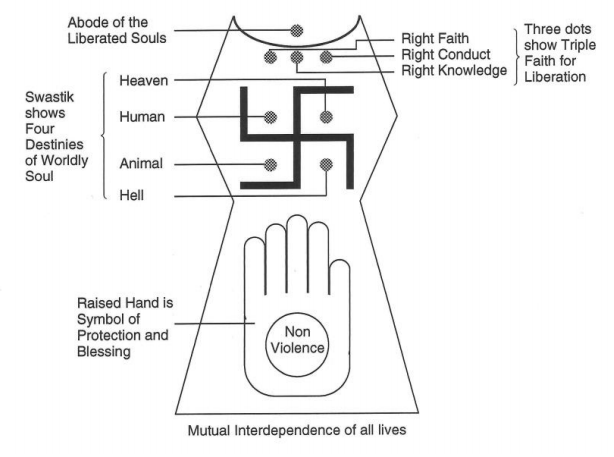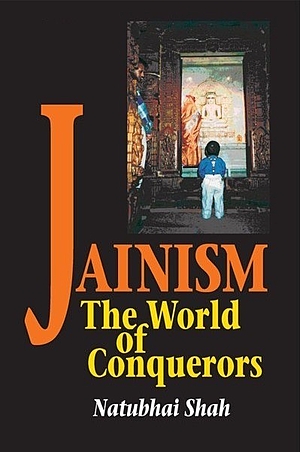This chapter describes the rituals of Digambar Jains, the rituals of the Sthanakvasis, Terapanthis, followers of Srimad Rajcandra, of Kanji Swami and of Dada Bhagwan, the rituals for the initiation ceremony of ascetics and the 'holy death' (sallekhanaa or santhaaraa).
The majority of the Digambar rituals are variations on the essential duties. They may be classified as devotional, purificatory, expiatory, oblationary and ceremonial. Perhaps the most significant difference between Svetambar and Digambar rituals is the absence of the daily performance of pratikramana among the Digambar laity.
Devotional rituals include worship, prayers, chanting, incantations and pujaas. The Digambars perform many forms of pujaas, but their sequence is similar in each case. The general sequence of pujaa is the first stage of physical cleanliness through bathing and putting on clean clothing. The second stage of mental purity consists in the recital of hymns and mantras; going to the temple and seeking the permission of the guardian deities to enter by uttering the word 'nissahi' three times; veneratation of the images; and the three rounds of circuits around the shrine.
The third stage consists of making preparation for pujaa by wearing (i.e. changing into) clean 'temple clothes', followed by taking from the temple store-house the eight types of materials to be offered; cleaning the materials with water and arranging them on a pujaa tray, on which a ninth material is created by mixing together the original eight.
tray, on which a ninth material is created by mixing together the original eight. Each of the eight ingredients has its spiritual symbolism: Pure water symbolises liberation of the self and other beings from birth, old age and death. Sandalwood paste symbolises equanimity (sandalwood has a calming influence). Rice grains symbolise freedom from rebirth (polished rice grains will not germinate). Yellow rice grains (coloured with sandalwood paste) symbolise purity and control over the passions. Coconut symbolises freedom from the feeling of hunger. Coloured coconut (coloured with sandalwood paste) symbolises the destruction of the darkness of delusion. (this ingredient replaces a lighted lamp). Incense symbolises the destruction (burning away) of karma attached to the soul. (this is 'purely' symbolic, as the incense is not incinerated). Almonds, betelnuts and cloves, used in place of fruit, symbolise the fruit of liberation. The mixture of the eight ingredients symbolises the desire to achieve liberation. In order to avoid harm to one-sensed beings, Digambars do not use flowers or lighted lamps or fruits in their pujaa.
Digambar pujaa (Jain, H. 1988: pp.38-70) begins with the devotee's placing a pujaa tray on a wooden stool, while an empty pujaa tray stands on a second stool. The empty tray is marked with a swastika using sandalwood paste. A small jina image from the shrine is carried, to the accompaniment of traditional recitations, and placed on the empty pujaa tray. Clean filtered water is sprinkled over the head of the image. This sacred water, called gandhodhak, is then taken and applied by devotees to their head and eyebrows.
This anointment of the image is called the 'stream of peace'; although generally water is used for this purpose, other liquids such as ghee, milk, curd, sugar-cane juice and a liquid mixture of herbal extracts can also be employed. If liquids other than water are employed, the final anointment should be made with a jet of water, so that the image remains clean. In elaborate pujaas, this anointing is performed with 108 pots, each pot representing an attribute of the panca parmesthis. After the anointing, veneration of the jina is performed, accompanied by the recitation of sacred verses. Then yellow rice grains are sprinkled in all directions to purify the surroundings.
Pujaas are performed for the veneration of the vows, places of pilgrimage, jina temples and jina images, the sixteen attributes of the tirthankara and the ten-fold religious observances. Of the many types of pujaas performed, each comprises the above sequence. At each stage, there are five invocations: the main deity (or deities) of pujaa, the scriptures and preceptors, the liberated ones, the twenty present tirthankaras of Mahaavideha region as described in the sacred geography, the panca parmesthis, and the individually-named tirthankaras.
Following the invocation of a deity, the devotee recites a sacred mantra, meditating on the deity invoked. The eightfold offering to the deities is made accompanied by the recitation of each offering in sequence.
The last stage of the pujaa is the recitation of the verses of veneration of the conception, birth, renunciation, omniscience and liberation of the tirthankaras (panca kalyaanaka). It is followed by the recitation of the 'victorious garland' (jayamaala), consisting of the attributes of the jinas, followed by the ninth offering of the mixed materials. After these offerings, devotees perform aarati and pray for the happiness and peace of the world by reciting the shanti paatha. Devotees conclude by praying to the deities invoked for the forgiveness of any faults or omissions made during this ritual.
The pujaa with material offerings is intended to lead to psychic (bhaava) pujaa. Incantations of mantras, such as the Navakara Mantra, and the recitation of hymns and eulogies, such as the Bhaktamara Stotra, Kalyaana mandir Stotra, and many others are psychic forms of pujaas. Incantations, eulogies and incantational repetitions lead one into the deeper stages of meditation and the observance of equanimity.
Purificatory Rituals consist of the practices of equanimity and penitential retreat; the recitation of hymns and eulogies in praise of the tirthankaras and torch bearers, incantational repetitions, and self-study.
Long purificatory rituals, lasting for three to ten days are known as vidhaanas. In recent decades they have increased in popularity. They are mass rituals and serve to increase the cohesion of the community and raise funds for temples. Nowadays, vidhaanas such as the 'pujaa of the nine planets', the pujaa for peace, and the pujaa for indra dhvaja are observed by some to alleviate individual, family and social calamities, mimicking Hindu ritual practices.
Expiatory Rituals: These rituals, aalocanaas, consist of confession for the transgressions of Right Conduct before a preceptor or a consecrated substitute. Devotees seek penance as prescribed in the scriptures, and try not to repeat the transgressions.
Oblationary Ritual: Digambar oblationary rituals show Hindu influence. They are intended to provide both social and individual benefits and are sometimes included in vidhaanas.
Ceremonial Rituals: Ceremonial rituals consist of performances of one or more day's duration involving the celebration of mythological stories, image and shrine consecration ceremonies, head-anointing ceremonies and chariot processions. They are colourful and very popular mass rituals involving thousands of people.
At the conclusion of most religious festivals, to raise the temple fund in a traditional way, a ceremonial ritual, known as flower garlanding (phula maala) is observed, where the devotees bid for the privilege of wearing garlands named after deities or attributes of the jinas. The devotional atmosphere on such occasions is enhanced by religious music, dances and chanting, which stimulates higher bidding (Jain H 1988: pp.74-78)
Digambar non-image-worshippers generally follow the rituals of other Digambars, with the exception of rituals associated with temples and images, instead they worship the scriptures.
Rituals of Other Sects
Sthanakvasis and Terapanthis do not venerate images and have few rituals. Their daily life is otherwise similar to the Svetambar image worshippers. They perform pratikramana and saamayika and observe paryusana, ayambils, fasting and other austerities. They also observe paakhi, with an elaborate pratikramana and other religious observances, on the final day of each half of a month.
Terapanthis celebrate paatotsava on the installation anniversary of their aacaarya, and maryaadaa mahotsava, where ascetics and community leaders gather for a festival of restraint, penance and renewal of their vows. Followers of Srimad Rajcandra: The spiritual mentor of Mahatma Gandhi, Srimad Rajcandra, stressed the importance of ethics and self-realisation over rituals. His followers perform many of the usual Jain rituals such as saamayika, incantational repetitions, eulogies, recitations of confessional worship, and self-study, and they celebrate the same festivals as other Jains. They designate themselves 'liberation desiring' (mumuksus). Rajcandra's followers celebrate guru purnima on the anniversary of his birth, spending the day in equanimity practices and self-study. It is customary to conclude the celebration with a community dinner.
Followers of Kanji Swami have a philosophy that places emphasis on the attributes of the soul. They observe daily rituals similar to the majority of the Digambar laypeople, including the performance of vidhaanas, pujaas and self-study. They also call themselves mumuksus.
Followers of Dada Bhagwan: Followers of Shri Ambalal Patel (1908-1988 CE), known to his devotees as Dada Bhagwan, observe similar rituals to those of the Svetambar murtipujaka. They emphasise the ethical aspects of Jain values in their daily life and attempt to identify themselves with pure soul. They worship Simandhar Swami, an existent tirthankara in the Mahaavideha a region of the Jain geography. Their rituals are largely devotional and include hymns, equanimity practices and meditation on the attributes of the pure soul. Many of them also follow the philosophical teachings of Srimad Rajcandra (Dundas 1992: pp. 218-232, and 1997: information collected from the followers).
For last few decades some Jains, especially in Western countries, believe in promoting Jain values beyond the sectarian boundaries. Jains will attend and take part in the rituals of the other sects, if invited.
Initiation of monks and nuns
The process of becoming an ascetic, saadhu or saadhvi, is termed 'initiation' (diksaa). The whole process of preparation, blessings, rituals and ceremony may take several months. Aspiring ascetics are invited to different homes and there they are offered respect and good wishes in their pursuit of the path of the jina.
The ritual of initiation begins with the public interrogation of aspirants by the aacaarya on their motives for adopting the ascetic life. The community celebrates by taking the aspirants in grand procession around the locality, during which, aspirants cast handfuls of mixed sacred ingredients, including gold and silver coins, to the crowds, symbolising their renunciation of material possessions. Devotees often keep these coins as sacred souvenirs. The procession ends with the presentation of the candidates before the aacaarya, who directs his disciples to pluck hair from candidates' scalps, and presents them with the garments and the necessary equipment of an ascetic. Then the aacaarya administers the oath of 'all the vows' (sarva virati), by reciting the Karemi bhante Sutra. New ascetics are given new names with which to start a new life.
Sutra. New ascetics are given new names with which to start a new life. Some Svetambar aspirants are initiated temporarily, perhaps for one or two years, and only when the aacaarya is satisfied, the provisional ascetic is granted permanent ascetic status by means of a small ritual ceremony.
Among Digambars, laypeople are initiated in stages through the eleven pratimaas and at the seventh stage, aspirants accept the vow of complete celibacy and practically renounce household activities. At the eleventh stage, they are initiated into the position of a minor ascetic (ksullaka) with upper and lower garments ('two-clothed'), and when he (there are no Digambar female ascetics in the strictest sense) advances spiritually further, he is initiated as a major ascetic (ailaka), with one garment ('loin-clothed'). Both ksullaka and ailaka are wandering recluses. The ailaka's is the last stage of laity and first stage of regular ascetic. Finally when he feels confident to be initiated as muni, he requests an aacaarya to initiate him, the aacaarya obliges him and, then, he gives away all his clothes and becomes a sky-clad ascetic, a muni (Jain J. 1983: pp.90-91)
Ritual of Holy Death
Birth and death are the initial and terminal miseries of the world. Jains believe in rebirth until liberation and celebrate both birth and death: with birth the human acquires a body which can be used to obtain liberation, and death is an opportunity to gain a new body.
Jainism teaches that one should not be afraid of death; the moment of death is very significant and one should leave the body peacefully in auspicious meditation, avoiding a new influx of the evil karma of attraction and aversion. Jains advocate a concluding ceremony for a life, as the whole of life is viewed as a preparation for a sacred death. This 'sacred death' ritual (sallekhanaa) is specific to Jainism. When one feels one has made full use of the body for spiritual advancement, and that one's body is of no further use, the vow of 'holy death' has been suggested in the Jain scriptures. It has been misunderstood by many in the West, as well as a few in the East, as being a form of suicide, but Jains do not regard this practice as suicide, rather it is a ritualised leaving of the body, as the purpose of holy death is spiritual advancement, it requires determination and spirituality. Suicide is regarded by Jains as a major sin, involving violence to human life.
Other than the completely voluntary act, there are five sets of circumstances in which the holy death ritual may be performed:
- conditions of extreme calamity (e.g. captivity and torture by an enemy);
- acute famine (where acceptable food is unobtainable); 281
- extreme old age (accompanied by physical and mental impairment; rendering religious observances impossible);
- terminal illness or fatal injury;
- when imminent natural death is predicted by astrological and other prognostications.
The first condition is that the ascetic or the surrogate supervising the ritual must be satisfied of the capacity of the aspirant to undertake the ritual. Secondly, the family must give their consent. The sacred-death ritual is generally, though not exclusively, undertaken by ascetics. The ritual must be observed without any of the transgressions mentioned in the scriptures.
The story of the thirty days long holy death ritual of Ananda (a rich merchant in Mahavira's time) and of the Aacaarya Skandhaka, are well known in Jain literature. Two modern holy deaths are equally well known: the Digambar Aacaarya Shantisagara underwent a thirty-six-day ritual in 1955 and, a layman, Jethabhai Javeri underwent a forty-two-day ritual in 1993, are examples which indicate the unbroken continuity, popularity and strength of the ritual.
This ritual may be observed in the home, a forest, a holy place or an upashraya. The ritual consists of the stages as given below:
- The aspirant first seeks the required permissions and takes the vow.
- The aspirant gradually renounces food, first solids, then liquids and finally water.
- Time is spent in engaging in penitential retreat, recitations of confession, condemnation and atonements, asking for forgiveness from all and forgiving all, devotional and auspicious recitations, repetitions of the rosary, scriptural studies, meditation with bodily detachment and reflections on auspicious activities.
- Besides food, one renounces physical attachments, the passions and sinful activities.
- Some accept the major vows of ascetics before the expected death.
- Silent recitations or listening to the Navakara Mantra are undertaken to venerate and take refuge in panca paramesthis (Jain J.1983: pp.97-99).
Jain Symbol:
Figure 5.7 The Jain symbol was adopted in 1969 CE at the 2,500th anniversary of moksa of Mahavira. (It depicts the transmigratory cycle and the path to liberation)

 Dr. Natubhai Shah
Dr. Natubhai Shah
